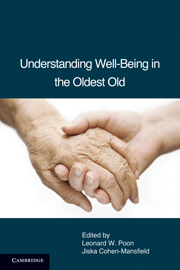Book contents
- Frontmatter
- Contents
- List of Tables
- List of Contributors
- Foreword by Carol D. Ryff
- PART I THEORY: NEW HORIZONS IN WELL-BEING RESEARCH
- PART II PARADISE LOST: BETWEEN TRAUMA AND HAPPINESS
- PART III PATHWAYS AND GATEKEEPERS: MODERATING, MEDIATING, AND PROXIMAL PROCESSES
- PART IV SIGNPOSTING PARADISE: MEASUREMENT OF WELL-BEING
- 15 Culture and Meaning: Strategies for Understanding the Well-Being of the Oldest Old
- 16 The Will to Live as an Indicator of Well-Being and Predictor of Survival in Old Age
- 17 The Measurement of Life Satisfaction and Happiness in Old-Old Age
- 18 Late-Life Psychotherapy: Challenges and Opportunities to Enhance Well-Being in the Oldest Old
- 19 An Integrative Summary and Future Directions in the Study of Well-Being
- Index
- References
17 - The Measurement of Life Satisfaction and Happiness in Old-Old Age
Published online by Cambridge University Press: 05 August 2012
- Frontmatter
- Contents
- List of Tables
- List of Contributors
- Foreword by Carol D. Ryff
- PART I THEORY: NEW HORIZONS IN WELL-BEING RESEARCH
- PART II PARADISE LOST: BETWEEN TRAUMA AND HAPPINESS
- PART III PATHWAYS AND GATEKEEPERS: MODERATING, MEDIATING, AND PROXIMAL PROCESSES
- PART IV SIGNPOSTING PARADISE: MEASUREMENT OF WELL-BEING
- 15 Culture and Meaning: Strategies for Understanding the Well-Being of the Oldest Old
- 16 The Will to Live as an Indicator of Well-Being and Predictor of Survival in Old Age
- 17 The Measurement of Life Satisfaction and Happiness in Old-Old Age
- 18 Late-Life Psychotherapy: Challenges and Opportunities to Enhance Well-Being in the Oldest Old
- 19 An Integrative Summary and Future Directions in the Study of Well-Being
- Index
- References
Summary
ABSTRACT
Happiness and satisfaction with life has emerged as a renewed topic of interest among gerontological investigators. However, the conceptualization of life satisfaction and happiness in advanced later life can present challenges relative to selection of proper measurement instrumentation. This chapter addresses the conceptualization and measurement of life satisfaction and happiness in very old age in three key ways. First, the conceptualization of subjective well-being is addressed in reference to the oldest old. Second, psychometric properties pertaining to past and current use of classical (e.g., Life Satisfaction Index-A), second-generation (e.g., Satisfaction with Life Scale), and domain-specific (e.g., Retirement Satisfaction Index) measures of subjective well-being within old and very old populations is addressed. Third, future directions for the advancement of measurement of subjective well-being in old-old populations are highlighted.
INTRODUCTION
In Chapter 3, Shmotkin referred to subjective well-being as a “dynamic and flexible agent of adaptation” in old-old age. Gerontologists have a long history of developing quantitative instruments to assess feelings of satisfaction and the pursuit of happiness in later life (Ferraro & Schafer, 2008). Yet reliable and valid psychometric tools to evaluate subjective well-being among exceptionally old adults can be difficult to find. As Fry and Ikels highlighted in Chapter 15, the well-being construct is conceptually sound but often too complex to operationalize. This is a possible explanation for why quantitative assessments of subjective well-being have yielded mixed results.
- Type
- Chapter
- Information
- Understanding Well-Being in the Oldest Old , pp. 290 - 331Publisher: Cambridge University PressPrint publication year: 2011
References
- 4
- Cited by



